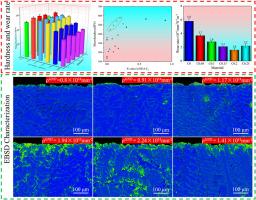碳含量对FeCrMn1.5AlCuC高熵合金组织和摩擦学性能的影响
IF 4.8
2区 材料科学
Q2 CHEMISTRY, PHYSICAL
引用次数: 0
摘要
研究了碳含量对FeCrMn1.5AlCuCx (x = 0, 0.05, 0.1, 0.15, 0.2, 0.25)高熵合金显微组织和摩擦学性能的影响。结果表明:合金的相组织为BCC、B2和L21相,具有典型的枝晶组织;随着碳含量的增加,合金中碳化物析出的临界碳含量在0.10 ~ 0.15之间。纳米碳化物C (Cr, Mn和Fe)出现在合金的枝晶间组织中。当x = 0.2时,合金具有优异的摩擦性能,硬度为576 HV,磨损率为1.6 × 10−6 mm3 N−1 m−1。与无碳合金相比,x = 0.2合金的硬度提高了40.97%,磨损率降低了27.59%。当纳米析出相的尺寸为151.43 nm,体积分数为18.6%时,碳驱动优化能最有效地提高合金的性能。本文章由计算机程序翻译,如有差异,请以英文原文为准。

Effect of carbon content on the microstructure and tribological properties of FeCrMn1.5AlCuC high-entropy alloys
This study investigates the influence of carbon content on the microstructure and tribological properties of FeCrMn1.5AlCuCx (x = 0, 0.05, 0.1, 0.15, 0.2, 0.25) high-entropy alloys. The results show that the phase structure of the alloy comprises BCC, B2, and L21 phases, with a typical dendritic microstructure. With the increase in carbon content, the critical carbon content for carbide precipitation in the alloy ranges from 0.10 to 0.15. Nanometric carbides of C (Cr, Mn, and Fe) have appeared in the interdendritic structure of the alloy. When x = 0.2, the alloy exhibits excellent friction performance, with a hardness of 576 HV and a wear rate of 1.6 × 10−6 mm3 N−1 m−1. Compared with the carbon-free alloy, the alloy with x = 0.2 exhibits a 40.97 % increase in hardness and a 27.59 % decrease in wear rate. When the size and volume fraction of the nano-precipitates are 151.43 nm and 18.6 %, respectively, the alloy's properties are most effectively enhanced by carbon-driven optimization.
求助全文
通过发布文献求助,成功后即可免费获取论文全文。
去求助
来源期刊

Intermetallics
工程技术-材料科学:综合
CiteScore
7.80
自引率
9.10%
发文量
291
审稿时长
37 days
期刊介绍:
This journal is a platform for publishing innovative research and overviews for advancing our understanding of the structure, property, and functionality of complex metallic alloys, including intermetallics, metallic glasses, and high entropy alloys.
The journal reports the science and engineering of metallic materials in the following aspects:
Theories and experiments which address the relationship between property and structure in all length scales.
Physical modeling and numerical simulations which provide a comprehensive understanding of experimental observations.
Stimulated methodologies to characterize the structure and chemistry of materials that correlate the properties.
Technological applications resulting from the understanding of property-structure relationship in materials.
Novel and cutting-edge results warranting rapid communication.
The journal also publishes special issues on selected topics and overviews by invitation only.
 求助内容:
求助内容: 应助结果提醒方式:
应助结果提醒方式:


